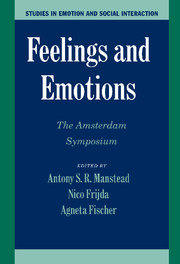Book contents
- Frontmatter
- Contents
- List of Contributors
- 1 Introduction
- PART I THE NATURE OF FEELINGS AND EMOTIONS
- PART II BASIC PSYCHOLOGICAL PROCESSES IN FEELINGS AND EMOTIONS
- PART III FEELINGS AND EMOTIONS: THE PLACE OF PLEASURE
- PART IV FEELINGS AND EMOTIONS IN THEIR SOCIOCULTURAL CONTEXT
- 18 The Development of Individual Differences in Understanding Emotion and Mind
- 19 Emotional Intelligence
- 20 Culture and Emotion
- 21 Emotion Norms, Emotion Work, and Social Order
- PART V FEELINGS, EMOTIONS, AND MORALITY
- Subject Index
- Author Index
- Plate section
- References
21 - Emotion Norms, Emotion Work, and Social Order
Published online by Cambridge University Press: 05 June 2012
- Frontmatter
- Contents
- List of Contributors
- 1 Introduction
- PART I THE NATURE OF FEELINGS AND EMOTIONS
- PART II BASIC PSYCHOLOGICAL PROCESSES IN FEELINGS AND EMOTIONS
- PART III FEELINGS AND EMOTIONS: THE PLACE OF PLEASURE
- PART IV FEELINGS AND EMOTIONS IN THEIR SOCIOCULTURAL CONTEXT
- 18 The Development of Individual Differences in Understanding Emotion and Mind
- 19 Emotional Intelligence
- 20 Culture and Emotion
- 21 Emotion Norms, Emotion Work, and Social Order
- PART V FEELINGS, EMOTIONS, AND MORALITY
- Subject Index
- Author Index
- Plate section
- References
Summary
ABSTRACT
The social origins and functions of emotion norms are examined. Emotion norms both reflect and sustain the social structures in which they develop. Individuals undergo emotional socialization and are subject to pressures to conform, especially adults in service and professional jobs, who actively manage reactions that violate social expectations. Efforts at emotional conformity help to sustain the social order, maintain hierarchy, and build solidarity. Emotional deviants are usually stigmatized and subjected to social control, but under some conditions they can become agents of social change.
An experiment by Dutton and Aron (1974) is often used in psychology textbooks to illustrate the role of cognition in emotional experience. The study was intended to demonstrate that physiological arousal can be misattributed to the wrong cause. Men who were approached by an attractive experimenter after crossing a suspension bridge over a deep gorge were more likely to indicate romantic or sexual interest in the experimenter, in contrast to men who had crossed a low wooden bridge over a stream. Dutton and Aron concluded, consistent with Schachter's two-factor theory of emotion (Schachter & Singer, 1962), that emotions are in part determined by available cognitive cues, not by physiological reactions alone.
- Type
- Chapter
- Information
- Feelings and EmotionsThe Amsterdam Symposium, pp. 359 - 378Publisher: Cambridge University PressPrint publication year: 2004
References
- 79
- Cited by

